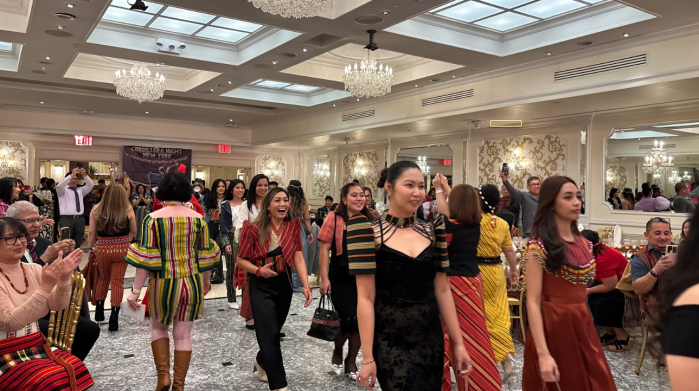
Women dressed in Cordilleran-inspired garments walk the runway. Photo by Cara Gepilano
Dec. 9, 2024 By Carrene Gepilano
The first-ever Indigenous Filipino-led fashion show, Cordillera Night, celebrated the vibrant traditions and modern interpretations of northern Indigenous Filipino fashion.
The event, held on Nov. 9, brought over 140 guests to Da Mikkel Palazzo in Woodside. It highlighted the rich craftsmanship of the Cordillera region of the Philippines, showcasing handwoven garments, intricate designs, and cultural pride.
The Cordillera region in the northern Philippines is known for its rich Indigenous culture and craftsmanship. The people of this mountainous area are renowned for their traditional handwoven textiles, particularly inabel fabrics, which feature geometric patterns inspired by nature. Many communities still use bamboo upright looms to create these intricate designs, preserving their cultural heritage while adapting to modern times.
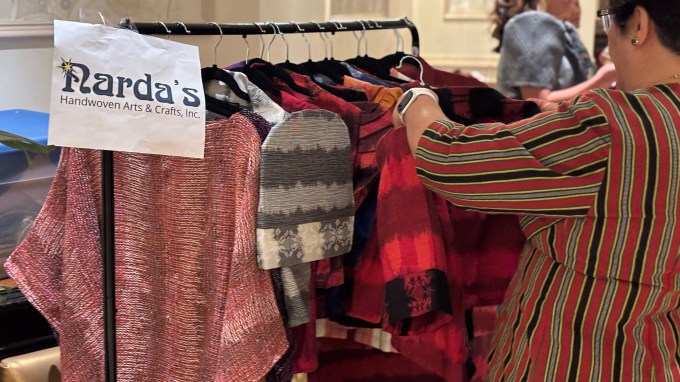
A woman is looking through handwoven tops from a clothing rack. Photo by Carrene Gepilano
The fashion show featured a mix of contemporary and traditional attire, blending modern fashion trends with the distinct geometric patterns and earth-toned fabrics of the Cordilleran communities. The evening unfolded with a surprise invitation for attendees to join the models on the runway, creating an atmosphere of unity and celebration of shared heritage.
“I wear this attire as a tribute to my roots, allowing me to carry my parents and my cultural identity wherever I go,” said Jet Lochinvar Saguid, a participant who wore a custom-made tribal-patterned shirt reflecting his family’s heritage.
The night was a visual feast of traditional handwoven gowns, skirts, and blazers, designed by pro-bono Indigenous Filipino designers. One of the designers was Bonsai Cielo, who wore a black maxi dress with a red wrap-around skirt, combining geometric patterns with floral motifs. Cielo, who is dedicated to reviving Indigenous textiles, shared her vision of incorporating sacred materials like the tapis into modern fashion. “My point was that you can only use the tapis so much; it deserves to be appreciated in all its forms,” she said.
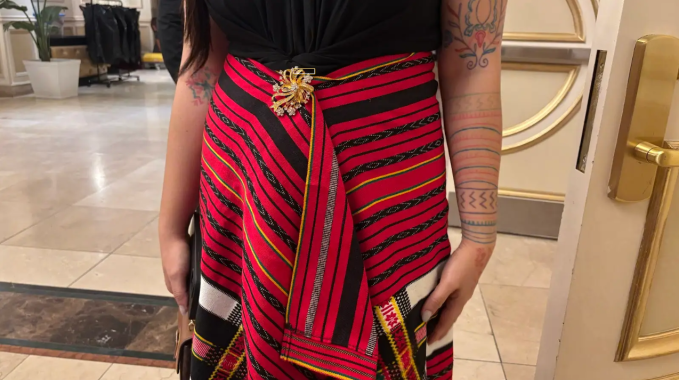
Bonsai Cielo wearing a tapis, a red-woven skirt with pa-igid and pinagpagan patterned-stripes. Photo by Carrene Gepilano
Olive Miguel, an event coordinator, wore one of Cielo’s designs—a navy blue empire dress adorned with arrow-patterned details—emphasizing how Indigenous clothing has evolved from ceremonial wear to everyday attire. “These attires were once reserved for special occasions, but now they’re a part of our daily lives,” said Miguel.
The event’s organizers stressed the importance of honoring traditional weavers from the Philippines who still use traditional looms, preserving the centuries-old techniques of inabel textile weaving. The garments displayed throughout the evening reflected the deep cultural significance of these textiles, with models walking down the runway wearing clothing that represented their specific provincial heritage.
As the show progressed, the audience admired the bold colors and vertical patterns, with the designs reflecting the distinct characteristics of the northern and southern Cordilleran provinces. “The materials were more varied from the south, while the north mainly used reds, blacks, and greens,” explained Cielo.
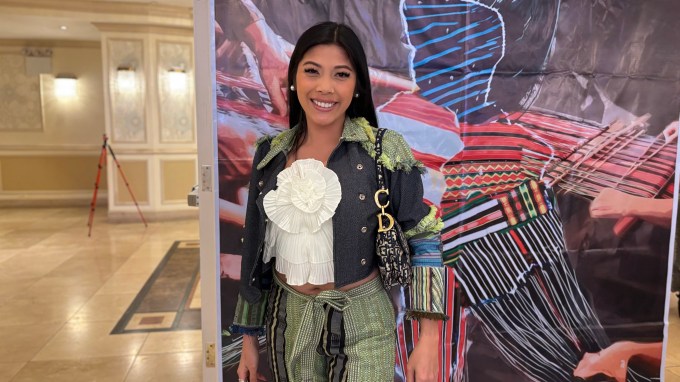
Janice Guhan posing in her denim, Kalinga-inspired outfit.
Among the guests, Janice Guhan wore an outfit combining tradition and modernity: light green pants detailed with vertical snake-like stripes paired with a denim jacket. Camilo Nacatab also showcased a fusion of styles, wearing a leather cowboy hat and a bright blue blazer with red and yellow geometric stripes.
Saguid, whose attire honored his heritage, concluded the runway show with a striking display of his custom-made shirt. “I’m proud to wear this piece that honors my heritage while reflecting my personal style,” he said.
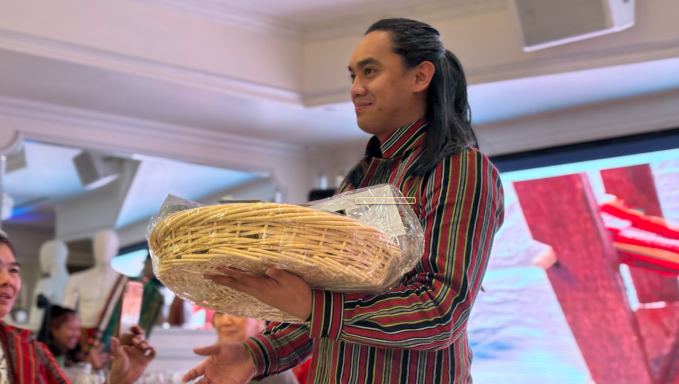
Jet Lochinvar Saguid holding a prize basket. Photos by Carrene Gepilano
The evening culminated in a celebration of culture, as Saguid was named best-dressed by a panel of judges. He won a gift basket, but the true honor, he said, was representing his family and heritage so far from home.
The celebration continued with a performance of traditional dances, including the Sisiwit, which mimics the movements of a bird’s wings, and the Pattong, a ceremonial dance of strength. By the end of the night, the atmosphere was filled with joy as attendees, including Saguid, danced in celebration of their shared heritage.
“We take pride in sharing this vibrant legacy on a global stage,” Saguid said, reflecting on the evening’s powerful display of cultural pride and unity.
No comments yet


